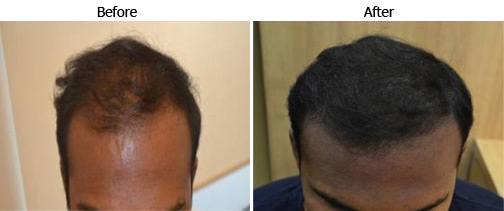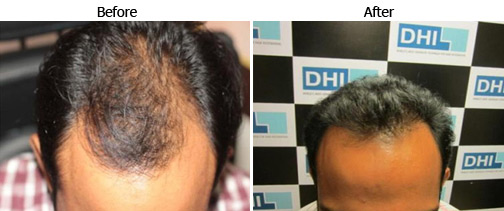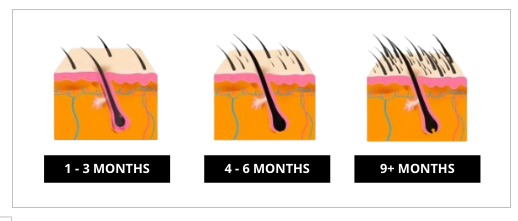One of the most common causes of hair loss in both men and women is patterned hair loss. Over 50% men at some stage of their lives are affected by it. There are a variety of hair loss treatments for both men and women in India. However, not all are effective at the advanced stages.
A hair loss treatment surgery or hair transplant procedure is a permanent solution for people at the advanced stages of hair loss. DHI hair loss treatment in India is the most trusted hair loss solution for people from all walks of life.
Our hair loss treatments are divided into two essential categories: surgical and non-surgical. Medications are non-surgical solutions while DHI hair transplant procedure is a surgical procedure.
Our hair loss treatment clinics in cities such as Delhi, Kolkata, and Bangalore among others follow standards operating procedure protocol, which apply to all levels and processes of the treatment.
DHI’s hair loss treatment surgery doctors are certified by London Hair Restoration Academy. All procedures from start to finish are performed by our surgeons only using US patented tools. There is no involvement of any technician/assistant during the procedure whatsoever. The procedure is completely safe and virtually pain free.


DHI - Direct Hair Implantation TechniqueDHI has successfully pioneered the world's most advanced direct hair implantation technique after more than 44 years of research. This unique method offers 100% guaranteed results without pain and scarring and is designed to achieve DHI's three objectives:
One of the primary reasons why men hesitate to undergo hair loss treatments is because they feel dubious about the risks associated with certain cosmetic procedures.
While it's true that hair loss treatments are virtually harmless, some complications may arise, as is the case with any form of surgery. However, the risk becomes even more prominent when the treatment is carried out by lab technicians instead of qualified medical experts.
Private clinics often use such technicians to perform these surgeries. While they are well-trained, they are not equipped with the knowledge to deal with potential complications that may arise during or after the treatment.
At DHI, we boast the world's largest medical team with a combined experience of over 80 years in the field. With them leading the vanguard of these complicated cosmetic procedures, our organization has recorded a customer satisfaction of over 99%, which is well above the industry standard.
Another question comes to mind is DHI technique for hair transplant procedure safer than traditional hair loss treatments?
Direct Hair Implantation is basically an upgrade over the traditional FUT and FUE techniques. The process involves extracting individual hair follicles from a donor area and implanting them directly into the affected site on the scalp.
The technique provides a much safer alternative to traditional hair transplant methods, wherein incisions or slits had to be made on the scalp before the implantation process commenced.
DHI, therefore, is considered to be much safer because the risk of infection, bleeding, and scarring is minimized. Moreover, as there are no incisions or slits, the amount of trauma suffered by the scalp tissue is also less, leading to quicker recovery times and a lower risk of post-procedure complications.
Despite these benefits, it should be noted by all clients that DHI does come with some slight risks of side effects or complications, as is the case with any kind of cosmetic procedure. But we have a team of experienced medical experts that are well-equipped to deal with any issue that may arise during or after the treatment.
A light and flexible cap lined with 108 and 272 true laser diodes thoroughly cover the entire scalp area. The product design allows for maximum laser light coverage without any manual movement. The product illuminates the hair follicles with monochromatic red laser light at a finely tuned wavelength and intensity.
This is based on US FDA-approved LLLT treatment which works alone also but gives great results with topical treatments and medication.
DHI Laser Cap is not just a product but an entire hair loss treatment in the comfort of your home. It stimulates skin tissues, encourages thicker hair follicles, heals damaged cells, helps with treating hair thinning, reverses hair loss, and enhances cell absorption & protein synthesis.
Laser wave technology uses the biological effects of laser on human skin to care for abnormal hair loss on the head. Its principle is to make a laser of a specific wavelength penetrate the cells under the head (hair roots and hairs), the deepest layer, to accelerate blood circulation, regulate endocrine, and improve hair quality.

In addition to resisting shedding, it can also make hair grow again. Laser irradiation significantly improves local blood circulation.
If used properly and professionally, hair extensions may significantly change the way you look. If wearing a wig or an extension of any type is a necessity, you can substitute your hair for as long as it is required.
The wigs ready-made or Special Orders are cut and styled on your head for a personalized result. Invisible caps also give a natural result.
Learn more about Cosmetic Hair Patches
DHI DIRECT MPG (scalp micro pigmentation) is a new promising method for handling the appearance of alopecia or great hair loss areas. A semi-permanent and permanent pigment/ink, like one of the existing hairs, is used to cover the area of the scalp which has lost hair by the creation of small spots resembling follicles. Practically, it is a kind of tattoo, with the difference that it is applied in spots mimicking the short hairs on a closely shaved scalp. The purpose of this method is to present the illusion of high hair density when applied on a thinning hair scalp area, a scalp that has been treated with hair implantation, or, when impossible, to treat the area otherwise. Therefore, the method is mainly very satisfying when the entire head has been shaved.
However, some hair transplant surgeons have begun utilizing this procedure to aid in thickening the appearance of naturally thinning hair.
Learn more about MPG
Another hair restoration option where you don’t have to undergo any sort of treatment or cosmetic procedure is using hair fibres. These are tiny fibres that are made of keratin or similar materials.
They can be sprinkled onto the affected sites on the scalp where the hair is thinner. Doing so will give you the appearance of having fuller hair. Hair fibres adhere to existing hair strands and can be styled like your natural hair. They are also available in a range of colours to fit well with your natural hair.
However, it should be noted that hair fibres are not as reliable as other options because they are flimsy and prone to being washed away quickly.
If the donor area in the back of the head is not sufficient, hair follicles can be obtained from the beard or the body and can be transferred into the hair loss areas.
Facial hair develops fast and grows back at remarkably high rates, exceeding 95%. Because of the specific texture of facial hair (they are wilder and curlier compared to scalp hair) and the fact that the shafts are twice as thick as scalp hair, they are not suitable for placement in the front hairline. However, they are extremely useful for the density of the middle zone or the crown and the restoration of postoperative strip scars.
Body hair is another alternative resource of hair follicles for Direct hair implantation, especially in men who have rich body hair, but insufficient donor site on the back of the head. All body hairs can be used as donors in hair transplants, the chest, the back, the arms, the legs, the pubic areas, etc. The most reliable and potentially usable areas for harvesting body hair grafts are the chest and the sternum. The final regrowth rate of body hair is unpredictable and usually ranges from 70 to 80%. Due to the different life cycles of body hair, which progresses more slowly than the life cycle of scalp hair, body hair regrowth is slower and may even take two years to be completed.
Facial and body hair can only be used in DHI, a Direct Hair Implantation technique, which permits the extraction of individual hair follicular units without incisions.
DHI hair transplantation, transfers individual hair follicles one by one, from a donor site to hair loss areas and is currently the ideal and most advanced method for male and female hair loss restoration. The Direct Hair Implantation method is also used for the restoration of eyebrows, body, or facial hair, as well as to cover the scars left by Strip or FUT technique.
Surgeries and natural treatments become essential after a certain point of hair loss. If you have been experiencing some of it, and want to pause further damage before you consult a doctor about the possibility of getting Direct Hair Implantation (DHI) treatment, you can take some precautions.
Here's how to stop hair fall before you consult a doctor or undergo any medical treatment:
Many people tend to get intimidated by the rapid deterioration following patterned hair loss. However, there are many natural as well as non-natural hair restoration options that they can opt for to reverse the process.
Direct Hair Implantation, for example, is the most reliable cosmetic hair loss treatment with minimal complications and maximum efficiency.
There are many non-medical hair restoration alternatives as well, like cosmetic patches, hair fibres, and scalp micropigmentation.
Sometimes, patterned hair loss can also be a symptom of increased stress levels or anxiety. In such a case, hair loss is naturally reversible. If you can manage your stress levels and bring them back to normal, your hair follicles will regrow naturally.
Eventually, it's fit to describe hair loss as a grave and common issue, but not one without any solutions. Whether you seek medical help or go with one of the non-surgical options, there are many pathways to choose from.